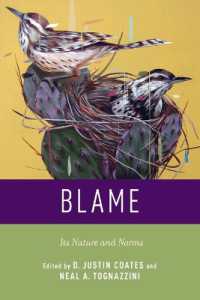Full Description
This highly novel book provides an exploration of the role of silence in the school setting and interrogates the value of silence and quiet in contemporary educational practices, looking at pedagogies and classroom practice to guide this increasingly popular subdiscipline of the history of education.
Arguably the first contribution written in English on the educational value of silence within the history of education more broadly, this book interrogates the way in which we encounter and label sounds and noises within the classroom, and the ways in which these have come to dictate relationships between teachers and pupils in our contemporary society. The chapters investigate sociocultural reasons for a Western problematization of silence and shyness of children, and the wider impact on class participation and treatment. The issues around children's sense of identity and teachers' authority are explored in relation to silence as a powerful tool for a progressive understanding of learning. Ultimately, the book will guide thinking around educational, acoustic surroundings and provide alternative vocabulary to talk about educational soundscapes and the real-term impact on our learning environments.
Providing a novel and nuanced framework for studying schools as acoustic or sound spaces, the book will be of interest to researchers, scholars, and academics in the fields of history of education, curriculum studies, and the theories of learning more broadly.
Translated by Emmeline Burdett on the basis of the original Dutch edition, Leuven University Press, 2022
Contents
Introduction: Listening to silence in the history of education
1. Silent practices in education
2. Research into silence in current pedagogical practices
3. A critical look at existing histories of silence
4. Towards a history of silence at school and in the classroom
5. The silent self, exemplary Bobby, and history as megaphone
Chapter 1: The rise of classroom-based silence
1. 'He squeals just like a thin pig, whose throat must be cut at once'
2. Noise and silence in the work of Jean-Baptiste de la Salle
3. Servile silence and philanthropic freedom
4. Regarding proper, exact, good, mechanical, sweet, or healing silence
5. A lesson in silence for the youngest children
Chapter 2: Maria Montessori's rediscovery of silence
1. The first cry of the newborn child
2. Silence, discipline, and the din of falling chairs
3. Silence exercises, whispering voices, and controlled liveliness
4. The meaning of silence for (the education of) teachers
5. 'If we want to reach silence, we have to educate them'
6. Reaching a new world through silence
Chapter 3: The silent child and the loud self
1. Silence and shyness
2. Dictation, exam questions, and observation lessons: the omnipresence of shy children in the classroom
3. The voice of the eighteenth-century Timidus: 'I'm not mad!'
4. From good and evil to normal and abnormal shyness
5. Social Darwinism and the noisy struggle for existence
6. The successful self, the culture of personality, and the war against shyness
7. Maria Montessori, self-education and shyness as monstrosity
Chapter 4: Silent reading and the child as open book
1. The art of reading aloud
2. Silent efficiency and the economisation of education
3. The rise of silent reading in the Low Countries
4. Silent reading tests and the call for responsible selection
5. Critical noises and the triumph of silent reading
Epilogue: Silence, the chargeable self and the direction of our future








